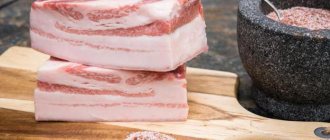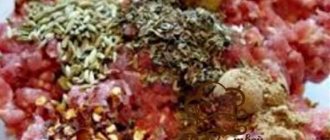How to salt lard? Pork lard is a very tasty product and an excellent source of energy due to its high calorie content. How to make delicious lard at home?
Steps . 1 First you need to choose the right lard. It can be homogeneous or have meat layers. In any case, you should check the product before directly salting. High-quality lard can be easily pierced with a knife and, therefore, will be soft. If the sharp end of the knife is placed in a jerky manner, then the lard contains too many veins. After salting it will turn out a bit harsh. Cut the product into slices if the thickness of the lard exceeds 6 cm. In any other case, you can salt the whole piece, but it will take a little more time.
2 Salting process. When salting, it is almost impossible to spoil this product, which, without a doubt, simplifies the process of preparing this delicacy.
No matter how much salt you add, the lard will absorb exactly as much as it needs. Ingredients: rock salt (you should choose it as it contains useful trace elements); red or black pepper (ground); black pepper (peas); any seasonings (feel free to add those that you like); Bay leaf; garlic (the amount can be completely different, depending on your taste preferences). Pickling mixture: per kilogram of product you will need 4 tbsp. spoons of salt, 1 tbsp. spoon of black pepper, 0.5. Art. spoons of red pepper, seasonings. For pickling, use a plastic or glass container
3 If you love the smell and taste of garlic, then add it to each plate. Keep in mind that lard salted with garlic will have a shorter shelf life. But if you keep the Ukrainian delicacy in the freezer, the shelf life will increase several times.
4 . At its bottom place a small amount of the resulting pickling mixture, peppercorns and crumble 1-2 bay leaves (to your taste). All of the above is again added to the top layer of lard. And this procedure is done with each piece. Store the lard at room temperature for the first 24 hours, and put it in the refrigerator on the second day. Then you can safely eat the product or store it in the freezer. First clean the pieces with a knife to remove any unnecessary pickling mixture. Bon appetit!
Source
Source: vkusno.mirtesen.ru
Yes or fix it?
Usually, after the described steps, salted lard becomes a homemade delicacy that most of the family wants to try. But incidents also happen. Is the product so salty that you can’t even bite into it? What is the reason? What to do if the lard is too salty? Do you really have to get rid of a delicious snack?
Don't panic. It is important to understand some nuances. Firstly, everyone's taste buds have different sensitivity. Don't just trust yourself in this case. Treat someone at home to a piece of this lard. Secondly, do not rush to say that the product is spoiled: do not judge the taste by the first bite. It's more salty anyway. Better cut off the next one and try it. Perhaps the lard will taste quite decent.
If the second taster confirms that you have gone too far with salt, then we will correct it. Below we will consider what to do if the lard is over-salted and eating it is unpleasant, and even unsafe for health in this case.
Dry salting
The simplest and most popular way to prepare lard for future use is salting by sprinkling with salt. The pieces are cut to the skin. Garlic cloves and other spices are inserted into the slits. What to do in this case, if you discover that the lard is over-salted? What to do in this situation?
This is perhaps one of the easiest ways to fix a product. In this case, it is enough just to remove such lard from the container and remove salt crystals from its surface. Use a knife to reach the slots in the product and remove them from there. After the described steps, the product will be ready for use and the taste will be much softer and improved. Now it’s clear what to do if the lard is too salty.
Oversalted lard in brine: what to do
First, rinse the product in clean and always cold water. This removes the surface salty layer. Dry the product with a kitchen towel, cut a piece and taste.
If the lard is over-salted, what should you do when the previous method did not help? You can try one more way. Pour cold boiled water into a container. Place the washed rice grains in a gauze bag. We send it into the water and then lay out the lard, cut into large pieces. After 6 hours we take it out. Remove drops of water by wiping lightly with paper napkins. Wrap the pieces in plastic wrap and place in the freezer for several hours. Now you can eat the lard. It became less salty.
Salting lard in brine at home
What is the advantage of salting lard in brine? It comes out juicier and is salted more thoroughly. Even initially harsh, in brine it turns into tender and juicy.
In the bank
The simplest, so to speak, “basic” recipe for lard in brine is this one, in brine. Let it become the basis for your original recipes.
Here are our “base” ingredients:
- a piece of bacon about a kilogram;
- water – one and a half liters;
- salt – volume as needed;
- bay leaves, a couple of leaves;
- garlic cloves – 3-4 pieces;
- black peppercorns – 5 peas.
- It’s easy to prepare the bacon: cut it into pieces so that it fits down the neck of the jar. You can, in principle, pickle a large slice by making transverse cuts.
- After peeling the garlic, chop it finely and add lard to it.
- Place the pieces in a jar.
- Now you need to make brine - brine for salting lard, it is prepared quite interestingly. Invite your children to watch the process - they will love it!
- Pour the water into a saucepan and throw a handful of salt into it. We put it on fire. Ordinary potatoes will help us determine how ready the brine is. We clean it and throw it into salt water. As soon as the brine boils, add salt until the potatoes float to the surface. After this, remove the salinity indicator. And put the bay leaf and pepper, let it boil again and set aside - the liquid should cool, pour lard into it in a jar.
Before salting lard in brine, do not forget to rinse the jar with soda or sterilize it - although the salt solution is very saturated, microbes cannot be given the slightest chance to spoil the product! Salting is completed already on the 10th day of keeping the jar in the refrigerator.
Hot way
Another interesting recipe that gives excellent results is salting lard using a hot method at home.
What's unusual here? And the result is lard with a slight smoked taste, and there is just enough salt in it, and the consistency is tender - in general, it’s beautiful! We select and prepare pieces of bacon as for other recipes. We take approximately 1 -1.2 kilograms.
And for the brine, let's take:
- water - liter;
- non-red onion peel - 2 handfuls;
- bay leaf – 2 pieces;
- salt - half a glass;
- black peppercorns – 5 pieces;
- hot pepper - 1 piece;
- a packet of spice mixture.
- Place the previously washed husks into a saucepan. Fill it with water, season the future brine with the rest of the spices and salt. For more delicious and quick recipes for lard in onion skins, see here.
- Let the brine boil.
- After a couple of minutes from boiling, add the lard into the saucepan. Without allowing the brine to boil violently, boil the contents of the saucepan for about 10 minutes. Remove the lard and dry.
- You can rub each piece with crushed garlic and pepper. Then wrap one at a time in cling film. Place in the refrigerator for a day. Then put it in the freezer for a couple of hours. Everything - you can eat! Just a day - and the snack is ready!
Cold way
There are several ways to salt bacon with cold brine. Here are the simplest ones:
- Prepare the brine brine as described above. Let it cool completely. Pieces of lard about the thickness of your palm, turn them over with the flesh facing up. We make small cuts in it with a knife and stuff it with garlic and black pepper. Place the lard in layers in a pan, placing bay leaves between them. Fill with brine so that it covers the pieces completely, and put pressure on top: the lard must not float! Cover with a lid and wait 2 weeks. Keep the saucepan in a cool place.
- Express salting in 3 days. Cut the lard into small pieces (2 fingers thick) and place in a jar. Laying in layers is preferable. We make brine like this: per liter of water - 3 tablespoons of salt. Boil and cool. Throw bay leaves and peppercorns into the jar. Fill with brine. Let's not forget about oppression. The jar sits at home for a day and then sits in the refrigerator for another two days.
- Taking the lard out of the brine, dry the pieces and rub, without being greedy, with a mixture of grated garlic and ground black pepper. Wrap in foil or cling film and place in the freezer.
With garlic
The recipe for salting lard with garlic in brine turns out very well. The salsa is aromatic and tender, just melts in your mouth. And even if it was initially a bit harsh, salting the lard in a marinade with garlic will correct this.
This cold, hearty appetizer is easy to prepare. We select lard according to general principles. The thinner the skin, the better. The presence of meat layers is welcome.
You can take both winter and summer garlic, but you should choose larger heads - the cloves in them are juicier and more aromatic. And it is better to avoid salt with any additives - you need pure, coarsely ground salt.
You can salt it in a saucepan or in a jar - whatever you like. Cut the lard pieces into medium slices.
The ingredients in the brine are as follows:
- water – 1.2 liters;
- garlic cloves - from 5 pieces (more is possible - as you like!);
- coarsely ground rock salt – 6 full tablespoons;
- allspice and black peppercorns – 4 pieces each;
- laurel leaves - 3 pieces;
- after - for grating lard - a mixture of peppers - a bag.
Cook the brine:
- Salt the water and put it on the stove. Peel the garlic. We thinly cut each clove lengthwise into petals. We throw it into the pan, along with the bay leaves and peppercorns. Wait for it to boil and boil for 3 minutes.
- Remove the saucepan from the stove and allow the brine to cool slightly - up to 70 degrees. Place the lard pieces, skin side down, in another saucepan, pour them with garlic brine. You will need some pressure on top.
- When the brine has cooled at room temperature, transfer the bacon to the refrigerator for 5 days.
- After this, remove the lard from the brine, dry it with paper towels and rub with a mixture of peppers. Then wrap it in foil and place it in the freezer to freeze. You can serve it to the table in just a couple of hours - just in time to prepare the borscht!
For smoking in brine
Preparing bacon for home smoking is salting. How to salt lard for smoking correctly? It's simple!
You need to salt it in brine. And to prepare it you need the following products:
- brine base - water: liter;
- coarsely ground salt – 150 grams.
Let the water boil and dissolve the salt in it. When this simple marinade has cooled, put lard in it under pressure and put it in the refrigerator for a day. Then remove from the brine - and that’s it, the lard is ready for hot smoking.
Another good, but more time-consuming way to salt lard for hot smoking is this:
For a kilogram of the main ingredient we take:
- soy sauce – 100 grams;
- garlic – 5 cloves;
- salt and spices to taste.
- We prepare pieces of fresh bacon: peel the skin and cut into pieces.
- We prepare the marinade as follows: mix soy sauce and salt with spices and garlic pressed through a garlic press in a bowl. Then carefully rub it into each piece of salsa. The entire surface should be covered with marinade!
- Place the pieces in a saucepan and cover with a lid. You need to keep the bacon in the marinade for 2-3 days - during this time the pieces will be well soaked and acquire a magical aroma.
Here are how many ways there are to pickle lard at home. And these are not all the variations on the theme of preparing the favorite snack of Ukrainians and Russians. Cut yourself a slice of homemade salsa, and with it some green onion, some black bread, a scoop of borscht with sour cream, maybe a glass of white wine - it’s beautiful! And don’t be afraid that lard is high in calories – if you eat a little of it, your waist won’t become blurred. Although... it’s so difficult to resist cutting yourself off from the fragrant snow-white slice, with golden skin and burgundy layers of lard! Enjoy your meal!
Watch how to pickle lard in brine, video:
Did you like the article? Share with your friends!
5594
Cooking method
Didn't the methods described above help? You can free lard from a shock dose of salt as follows. Boil water in a small saucepan. And boil several small pieces for no longer than one to three minutes. Excess salt will go into the broth. Remove the pan with lard from the stove and add a few cloves of garlic, after crushing it.
Cool the contents of the pan and place the lard in the resulting brine in the refrigerator for a day. Remove after 24 hours for tasting. Do not forget to remove excess moisture and store this product in the freezer.
Over-salted smoked lard
What to do when, due to the taste of salt, the taste of the smoked product is not captured? The simplest and most accessible action is to remove the skin from a piece of lard. Perhaps after this it will become less salty. It all depends on the dose used during the salting process. If possible, the meat layers on the underside of the lard should be cut off and used in the preparation of any dish. For example, you can fry potatoes with them without adding salt.
You can, as in the previous versions, soak the lard and smoke it again. But then the product will not have the taste we expect.
Boiled smoked lard
Everyone will agree that lard prepared with your own hands at home is not only much tastier than store-bought, but also healthier. Indeed, in this case, no flavor enhancers, stabilizers or other additives are used for cooking. Cooked-smoked lard is not only surprisingly tasty, but also looks beautiful.
To prepare you will need:
- kilogram of lard;
- water – 4 liters;
- salt – 100 gr.;
- laurel leaf;
- peppercorns;
- foil;
- metal container;
- fruit tree sawdust.
Cooking process:
- Put bay leaf, salt, pepper into the water and boil.
- Put lard there and boil for fifteen minutes. Remove the product from the pan and place it in a bowl or on a board until it cools.
- Take a dry metal container (you can use a cauldron or a saucepan with thick walls). Place sawdust on the bottom.
- Place some kind of lattice stand over the wood chips. Next you need to put foil and lard on it. Cover with a lid and place on very low heat. Smoke for 30-40 minutes.
- After this, the fire must be removed, the container must not be opened, but left as it is until it cools completely, about eight hours. Serve thinly sliced on a platter, you can garnish with herbs.
When smoking lard, it is very important that the lid fits tightly to the vessel. Smoke should not come out.
Last resort
It happens that lard spoiled by salt simply cannot be consumed in the form in which it was intended. Shouldn't you throw it away? You can pass such a product through a meat grinder and dilute it with fresh lard. Add garlic to the mixture and mix all ingredients. The resulting minced lard should be stored in the freezer. You can use it while preparing dishes according to your own tastes and needs. It’s good to fry potatoes with this lard for lunch. Also, some housewives add it at the time of roasting. Lard, minced through a meat grinder, can be used to prepare many dishes. A thrifty housewife will find a use for it.
Source: fb.ru
How to remove excess salt from lard?
- A simple soak in cold water can help with this. So, in order to remove excess salt, you first need to clear the lard from the edges of the layer of accumulated salt. and then immerse the piece of lard in cold water for a couple of hours. Then, after testing, you will determine whether you need to continue soaking the lard.
- There cannot be excess salt in lard; it cannot be over-salted; it absorbs as much salt as it needs. Many salt it in jars, completely covering it with salt, or in water with a huge amount of salt and there is not and cannot be any excess salt, and before use you should simply peel it off with a knife, lightly sprinkle a piece of lard with water and you can eat it. There is no need to soak it, as its wonderful taste will be lost. For pickling, no time is spared on salt.
- Try scraping off excess salt with a knife, holding it perpendicular to the plane of the lard. Typically, lard is not salted deep inside; when using this salting method, most of the salt is present on the outside.
- I remember my parents salted lard in three-liter jars and sprinkled the pieces with salt very well.
Interestingly, when they pulled it out after a while, it was enough to scrape off the salt with a knife and the lard could be consumed.
It has the property of not taking in excess salt, only as much as is necessary for salting.
But if there is lard with a cut of meat, then in my practice it was the meat layer that was over-salted.
You can, of course, soak it in water, but we didn’t have time - so we ate it.
- The fact is that it is impossible to over-salt lard, because it takes as much salt as it needs. If the lard was simply salted with salt, then you can try to cut off or clean off the excess salt with a knife, you can also wash the salt from the surface of the lard with water and soak the moisture with a napkin.
- First we clean off the salt, then you can soak the lard in water, and change the water several times. Of course, a large piece should not be soaked. People have different tastes, but I like it with horseradish or mustard. There are a huge number of recipes. But initially, in order for the lard to turn out tasty, it is ground not with a gas burner (the lard then dries out), but with a blowtorch and then with straw (the military secret of the crests was revealed). The most delicious thing about a pig is its ears))).
- It has always been believed that lard cannot be over-salted by simply sprinkling it with salt. It has a layer of meat - yes.
But if you are not a fan of highly salted lard, then choose a few pieces for yourself, scrape the salt from them with a knife, put them in a saucepan, fill with water up to the level of the lard itself and boil.
A couple of minutes is enough, turn it off and add crushed garlic. Once it cools down, put it in the refrigerator along with the brine. This lard turns out tender, soft and not so salty - you should like it.
- There is such an unwritten rule. -quot;Lard will take in exactly as much salt as it needs, no more, no lessquot;. Personally, I strictly follow this rule. And if I need to remove salt from the surface, then I simply cut off with a knife the thin outer layer on which the salt is located. Inside, the product is usually harmonious in taste in terms of salt.
- If there is a lot, then I take a knife and scrape it off from the top of the fat. But it happens that the salt has already saturated the lard, and it needs to be removed from the inside. Then immerse the salt in water and place a piece of rice in gauze there. The rice will quickly absorb the excess salt.
- Usually lard does not absorb much salt. Only as much as needed for salting. If you still have too much salt, then you can simply remove it with a knife (just quot; scrape quot; e) and rinse off the remaining salt a little with cold water. Usually this is enough. If the lard has a layer and it is very salty, then such lard can be soaked a little in cold water. To improve the taste, roll/stuff with garlic and spices, let it brew for 2-3 hours (minimum) and put it in the freezer. Then eat it, cutting it thinly.
- In order for the salted lard to become less salty, you can keep it in warm water for about an hour and a half, or better yet, boil it altogether, then the lard will become tastier, softer and of course the excess salt will come out of it, leaving only a pleasant saltiness.
Source: info-4all.ru
How to remove salt from lard after salting
Disputes about whether it is possible to over-salt lard often move from purely culinary discussions to chemistry, biology, and even other subjects of the school curriculum. Facts are presented, assumptions are made, and things are still there.
The situation has become too salty; how to correct it and prevent mistakes in the future requires some preliminary explanations. Lard is a general name for the product, which doesn’t make it clear enough that you actually over-salted it.
It consists of fat (lard itself), thin mesh films inside it, layers of meat and skin (skin). Fat itself does not absorb salt at all; this must be clearly understood.
The mesh, which can be found when slicing, on the contrary, is salted wonderfully. It is she who leaves the impression that the lard is salty. Meat also absorbs a lot of salt; if you have a slice with a layer of it, some of it goes to the skin.
Such knowledge, with a reasonable assessment, suggests what to do if you have over-salted the lard. The first step, of course, is to peel off the layer of salt from the slices, then rinse them with cool, then warm, and finally again with cold water. If your lard is wet (brine) salted, just rinse it.
Next, it’s worth assessing the salinity of the product. Cut and set aside a piece from any edge, and try the next one. If the lard still seems too salty to you, cut off another piece and this time cut the outer edges into strips up to half a centimeter thick.
Of course, remove the skin and layers of meat. Don't worry, you probably won't have to throw away this yummy food. The lard you have left will be 100% edible.
What to do, how to remove excess salt from lard in order to save the appetizing layers? You have few methods, but they are quite effective. First of all, evaluate the thickness of the slices: will we remove fat from large pieces, or is it easier to cut off the layers?
The fact is that, depending on the method of cutting the lard, the amount of meat on portioned pieces may be insignificant, and in general they will not seem over-salted. If the lard is initially thin, and even half consists of layers, you just have to either boil it in unsalted water or soak it for several hours or days.
We will consider the second method separately, but let’s talk briefly about boiling lard, since this is not an entirely honest way to remove the salt from too salty lard. In fact, after heat treatment you will end up with a completely different product.
In addition to simple cooking, salted lard can be dissolved into thin slices and used to sandwich boiled pork before baking. Cut pieces from the edges of a slice are good for greasing a pan for pancakes; you can melt them a little and fry potatoes with cracklings in lard.
LiveInternetLiveInternet
Monday, March 26, 2012 10:24 + to quote book
Strange as it may sound, boiled lard not only has a right to exist, but is also very tasty. The only lard you need is “with a cut” - that is, with streaks of meat. Moreover, the more meat, the tastier. Accordingly, we buy undercuts - the underbelly of a pig. Skin is a must.
So, you will need: Pork lard with a slit and always with skin. Garlic. Salt. A couple of peas of allspice, the main thing is not to overdo it and not to overdo it. Bay leaf. It takes about 5-10 minutes to cook. First of all, pour water into the pan, in quantity - so that the lard is subsequently completely covered, but does not float like in the sea-ocean. Add salt to the water, the amount you usually add to the soup. Place on the fire and leave to boil. At this time, we take out the lard, singe it if necessary, carefully scrape the skin *https://*yourmeal.r*u with a knife so that the skin is clean and smooth. Cut the garlic into thin slices - quantity as desired. But you shouldn’t skimp too much. Rub a piece of pork with salt and place chopped garlic on the side of the meat.
Fold a piece of pork in half, or roll it into a roll if the piece allows it. Skin out, garlic in, of course.
We wait for the water with pepper to boil and add the prepared lard into it. We don’t reduce the heat, the main thing is to get it to boil again as quickly as possible.
I cook according to the time depending on the size of the piece, in this case it took about an hour to an hour and a quarter. The meat should be completely cooked. 10-15 minutes before the end, add bay leaf to the pan. After *http*://*yourmeal.ru finishing cooking, we take out the bay leaf and mercilessly throw it away. Turning off the heat, leave the lard in the pan to cool in the broth.
After cooling, two scenarios are possible: If you like elastic skin, then after cooling, take the lard out of the pan, wrap it in foil and put it under pressure in the refrigerator. If you need a soft skin, leave the lard in the broth without refrigeration overnight; if you prepared it in the evening, that is, for 8-10 hours. Then we take out the piece, free it from the shackles and cut it. Store later in the refrigerator in foil or parchment paper.
PS As a spice, you can add ground black pepper to the garlic inside the lard. Black *https://yourmeal.*r*u peppercorns can also be thrown into water. You can also add a bud of cloves, a little cinnamon, and cardamom to the water. You can also cook it in onion skins. source
| Categories: | let's have a snack |
Tags:
appetizer boiled lard
Cited 911 times Liked by: 139 users
Like share
0
Like
- 139
I liked the post - 911
Quoted - 8
Saved
- 911
Add to quote book - 8
Save to links
Liked139
0
How to soak over-salted lard
Simply pouring boiled water over the lard and keeping it in this state for six hours to a day can significantly reduce the salinity of the slices. Yes, exactly slices, since the lard should be cut in such a way that the layers are moistened as much as possible.
Is it worth changing the water and how much is needed? About a liter of water per kilogram of lard is enough; you should stir the water every couple of hours and turn the lard over. The temperature of the liquid during soaking is from +10 to +25 degrees, that is, you can soak the lard either simply in the air, in the kitchen, or in the refrigerator, if it is not too cold there.
Of course, before soaking the salted lard, it is wiped of crystals, and the thin outer layer can be cut off. Flavored water is often used for soaking: cold tea leaves, cooled decoction of spices or roots.
Source: www.moyakuhnya.com
Lard in a bag
Lard boiled in a bag turns out very juicy and aromatic. It will be appreciated even by those who were previously very skeptical about this product. It is very simple to prepare, but it turns out incredibly tasty.
If you purchased hard lard with a very coarse skin, prepare it in a bag. It will become soft and at the same time retain its dense texture.
For 1 kg of fresh lard you will need:
- 2 heaped tablespoons of salt;
- 8 cloves of garlic;
- 1 tbsp. l. peppercorns.
Cooking process:
- Crush the garlic with a knife.
- Crush the pepper lightly as well.
- Mix salt and pepper and garlic. Rub the lard well with this mixture.
- Take two regular bags, fold one into one and put lard in it. Tie as tightly as possible.
- Pour water into a large saucepan and put lard in the bag. You will need about two liters of liquid.
- Cover with a lid and cook over low heat for 1 hour.
- Then remove and place in a bowl to cool completely. Only after cooling can you remove the lard from the bag. Keep refrigerated.
During the cooking process, the lard in the bag will be on the surface of the water. Don't try to sink it to the bottom. Just cover the pan with a lid.
On this topic:
Useful viburnum - harvesting for the winter and methods...
Aug 4, 2020
We are preparing a fragrant dessert - pear jam for the winter,...
Aug 2, 2020
BACK FORWARD 1 of 257









